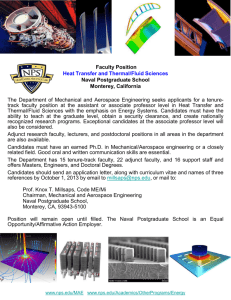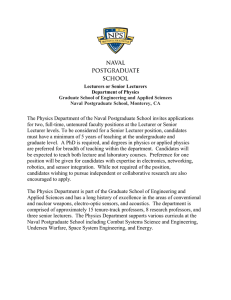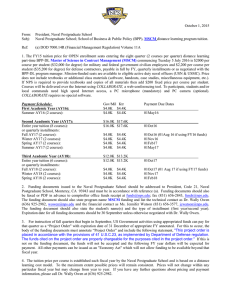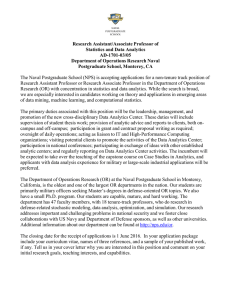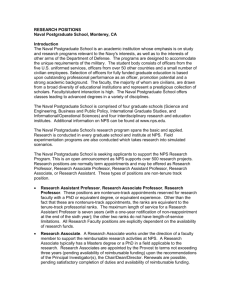Josh Dixon, Capt./USMC Naval Postgraduate School Delivering Smartphone Capabilities to the Battlefield
advertisement
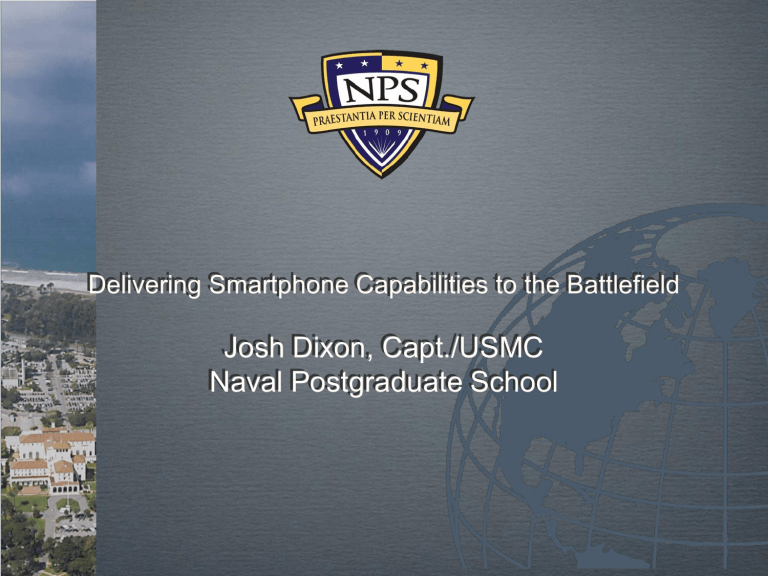
Delivering Smartphone Capabilities to the Battlefield Josh Dixon, Capt./USMC Naval Postgraduate School Delivering Smartphone Capabilities to the Battlefield Josh Dixon, Capt./USMC Naval Postgraduate School Outline • Overview of the Environment, Industry, and Technology • Proposed Concepts • • Handset • Service • Infrastructure Cost Savings Josh Dixon, Capt/USMC Naval Postgraduate School jsdixon@nps.edu Industry Overview Global Mobility Industry Regional Mobility Industry Service Provider Industry Handset Industry Application Industry Hardware Industry Component Industry Josh Dixon, Capt/USMC Naval Postgraduate School jsdixon@nps.edu Regional Mobility Industry Operating System Industry MNO Industry Infrastructure Industry MVNO Industry Handheld Solutions COTS GOTS TRADE OFF Motorola i1 (MIL-STD 810F) Blackberry L-3 (Curve 8900) (Guardian) General Dynamics (Sectera Edge) No military security specifications built spent annually in procurements $Millions into design (estimated quantity in the thousands) Josh Dixon, Capt/USMC Naval Postgraduate School jsdixon@nps.edu *images from vendors website Outline • Overview of the Environment, Industry, and Technology • Proposed Concepts • • Handset • Service • Infrastructure Cost Savings Josh Dixon, Capt/USMC Naval Postgraduate School jsdixon@nps.edu Handset Cost (drivers) Avg. wholesale*: $323.07 Avg. retail (2 year plan)*: $179.00 Josh Dixon, Capt/USMC Naval Postgraduate School jsdixon@nps.edu *images from www.ifixit.com *cost figures from www.isuppli.com **according to ABI Research Firm (as of June 2010) Handset Security Personal NIPRNET SIPRNET MILS Separation Kernel RTOS HARDWARE Limitations • Virtualization delays • Mitigated through multiple processors • Hardware virtualization vice software • Added cost Advantages Josh Dixon, Capt/USMC Naval Postgraduate School jsdixon@nps.edu • Higher level of assurances • Run multiple instances of COTS Operating Systems • Separate OS from hardware • Trusted applications receive dedicated resources Outline • Overview of the Environment, Industry, and Technology • Proposed Concepts • • Handset • Service • Infrastructure Cost Savings Josh Dixon, Capt/USMC Naval Postgraduate School jsdixon@nps.edu DoD Wireless Procurements $250 0.090% $200 0.070% 0.060% $120 $150 0.040% $100 $64 $27 $40 $25 0.020% $57 $60 FY2007 FY2008 FY2009 $40,000,000 $64,253,383 $97,407,712 $119,566,667 $10,000,000 $14,699,780 $26,876,967 $37,769,191 $19,473,117 $38,053,130 $46,823,658 $56,997,334 $59,517,776 0.032% 0.042% 0.046% 0.065% 0.076% $38 FY2005* FY2006* $25,000,000 $5,000,000 FISC NDWC Total % of Carrier Rev. $Army AAFBPA Total 0.030% $10 $5 $19 NMCI EDS Total $38 $15 $50 $47 * FY2005-06 – AAFPA and NMCI data estimates based on trends **commercial market trend line referencing carriers combine revenue as reported on annual financial records ***procurement data derived from the federal procurement data system (public access) Josh Dixon, Capt/USMC Naval Postgraduate School jsdixon@nps.edu 0.050% $97 0.010% 0.000% Percent of Carriers Revenue Total Obligated (Millions) 0.080% MVNO Concept • DoD (domestic) voice cost (calculate per minute rate) Average: $0.06 per minute Std. Dev.: $0.03 (majority of plans range $0.03 – $0.09 per min.) • Carriers cost Roaming Cost (FCC 2009 Report): $0.03 per minute DoD Cost per Region FY09 Fort Knox, KY (2%) Arlington, VA (17%) Washington, DC (3%) Anacostia Annex (2%) Washington Naval Yard (1%) Fort Bragg, NC (2%) Atlanta, GA (3%) Millington, TN (2%) Redstone Arsenal, AL (2%) Josh Dixon, Capt/USMC Naval Postgraduate School jsdixon@nps.edu *data derived from the federal procurement data system (public access) Spectrum Trade-off Sell-Off Spectrum and Lease Back Cost to government Maintain Spectrum Cost to government • Cost to lease spectrum • No fiscal expenses • Loss of dedicated spectrum • Opportunity Cost (Gov’t) • Lower capacity (smaller channels) • • • • Josh Dixon, Capt/USMC Naval Postgraduate School jsdixon@nps.edu revenue from selling spectrum commercial industry builds around spectrum shared R&D burden standards built around spectrum * DoD UCR 2008/2010 Section 6.1 (Unique Deployed Requirement) Outline • Overview of the Environment, Industry, and Technology • Proposed Concepts • • Handset • Service • Infrastructure Cost Savings Josh Dixon, Capt/USMC Naval Postgraduate School jsdixon@nps.edu Tethered Solutions Requirement - Integrate MILS Separation Kernel USB Dongle • Limitations • • • • USB Host Limited Mobility Power Inefficiencies Advantages • • • No commercial signal emissions Low Cost Shorter procurement timeline Sleeve • Limitations • • • Added hardware to handset Procure sleeve hardware for each handset (customized per phone model) Advantages • • • Josh Dixon, Capt/USMC Naval Postgraduate School jsdixon@nps.edu Transmit across military signals Potential for Type 1 encryption module or Suite B client Low Cost in comparison Lockheed Martin (MONAX) *images from vendors website Wireless Solutions Requirement - Integrate MILS Separation Kernel Secure (Encryption) WiFi • Limitations • • • Advantages • • • Added hardware Not LPD/LPI/LPE signal Operates on a non-licensed band Provides suite B link encryption Cost ($6-8K per squad) Commercial cellular (fixed cites) • Limitations • • • • • High opportunity cost for concentrated areas Coverage gaps Reoccurring usage cost Not LPD/LPI/LPE signal Advantages • • Preexisting network (no setup, maintenance/support) Shared cost burden with commercial market **images from vendors website Cost (avg. monthly service cost $25 - $30 per user)* *Current cost ($60 - $70 per user) Josh Dixon, Capt/USMC Naval Postgraduate School jsdixon@nps.edu Wireless Solutions Mobile Base Stations (Tactical design) • Limitations • • • • Advantages • • • Higher Cost (limited market) Scalability Not LPD/LPI/LPE signal Ruggedized All-in-one Solutions SiRRAN (NOMAD-EX 2G/3G) Cost • • Equipment: $15K – $250K+ (6 – 80 simultaneous users) Frequency lease: $5K – $6K LGS Innovations (RDN 4G) (TacBSR 2G) Ericsson Federal (QuicLINKs 3G) Modified Tactical Radio (host cellular signal) • Limitations • • • • High Cost Not LPD/LPI/LPE signal Modifications not on roadmap Advantages • No added hardware for infrastructure General Dynamics (JTRS HMS) Josh Dixon, Capt/USMC Naval Postgraduate School jsdixon@nps.edu *images from vendors website Infrastructure Security Trade-off SIZE = LEVEL OF SECURITY $500 Tactical Radios Cost (Millions) $400 $300 Cellular $200 Mobile BS $100 WiFi USB $0 $(100) Sleeve 1 2 3 4 5 Time (Years) 6 7 8 9 10 Outline • Overview of the Environment, Industry, and Technology • Proposed Concepts • • Handset • Service • Infrastructure Cost Savings Josh Dixon, Capt/USMC Naval Postgraduate School jsdixon@nps.edu Estimated Current Cost Secure Comms Cost • Service • • • • 1500 x $3000 = $4.5 Million Infrastructure • • 1500 x $70 x 12 = $1.25 Million Handset • Unsecure Comms Service • • 280K x $70 x 12 mo = $240 Million Handset/Data Cards • $600 Thousand Total: $240.6 Million annually $750 Thousand R&D • $50 Million Total: $56.5 Million annually $2.56B NPV (rough estimate 10 yrs) Proposed Savings • Spectrum • 165 x $5000 x 12 = 10 Million • Leased / Owned Infrastructure • 165 x 50 K = 50 Million • Handset • 450K x $300 = 135 Million (hardware and software cost) • Service • • 140K x $30 x 12 mo = 50 Million R&D • 25 Million Total: $270 Million annually Current Cost • $2.56 B (280K users) Proposed Cost • $2.16 B (450K users) Savings: $400MM (across 10 yrs) Increased Coverage Increased Capability Questions • Overview of the Environment, Industry, and Technology • Proposed Concepts • • Service • Handset • Infrastructure Cost Savings Josh Dixon, Capt/USMC Naval Postgraduate School Military Wireless Communications (research group) Email: jsdixon@nps.edu
